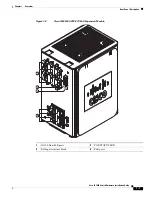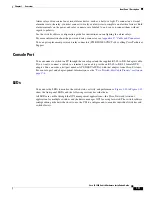
1-8
Cisco IE 3000 Switch Hardware Installation Guide
Chapter 1 Overview
Front-Panel Description
10/100 Ports
You can set the 10/100 ports to operate at 10 or 100 Mb/s in full-duplex or half-duplex mode. You can
also set these ports for speed and duplex autonegotiation in compliance with IEEE 802.3AB. (The
default setting is autonegotiate.) When set for autonegotiation, the port senses the speed and duplex
settings of the attached device and advertises its own capabilities. If the connected device also supports
autonegotiation, the switch port negotiates the best connection (that is, the fastest line speed that both
devices support and full-duplex transmission if the attached device supports it) and configures itself
accordingly. In all cases, the attached device must be within 328 feet (100 meters). 100BASE-TX traffic
requires Category 5 cable. 10BASE-T traffic can use Category 3 or Category 4 cables.
When connecting the switch to workstations, servers, routers, and Cisco IP Phones, be sure that the cable
is a straight-through cable.
For copper ports, you can use the
mdix auto
interface configuration command in the command-line
interface (CLI) to enable the automatic medium-dependent interface crossover (auto-MDIX) feature.
When the auto-MDIX feature is enabled, the switch detects the required cable type for copper Ethernet
connections and configures the interfaces accordingly. For configuration information for this feature, see
the switch software configuration guide or the switch command reference.
Dual-Purpose Ports
A dual-purpose port can be configured as either a 10/100/1000 port or as an SFP module port. Only one
port can be active at a time. If both ports are connected, the SFP module port has priority.
You can set the 10/100/1000 ports to operate at 10, 100, or 1000 Mb/s in full-duplex or half-duplex
mode. You can configure them as fixed 10, 100, or 1000 Mb/s (Gigabit) Ethernet ports and can configure
the duplex setting. (See the switch software configuration for more information.)
You can use Gigabit Ethernet SFP modules to establish fiber-optic connections to other switches. These
transceiver modules are field-replaceable, providing the uplink interfaces when inserted in an SFP
module slot. You use fiber-optic cables with LC connectors to connect to a fiber-optic SFP module.
For more information about these SFP modules, see the
“SFP Modules” section on page 1-8
module documentation or the release note for your switch software.
SFP Modules
The switch Ethernet SFP modules provide connections to other devices. These field-replaceable
transceiver modules provide the uplink interfaces.The modules have LC connectors for fiber-optic
connections or RJ-45 connectors for copper connections. You can use any combination of the supported
SFP modules listed in
.
















































